If you’re choosing between Zigbee and Wi-Fi for smart bulbs, consider your needs. Zigbee offers low power use, mesh networking, and easy scalability, making it great for extensive setups. Wi-Fi provides broader device compatibility, faster speeds, and simple direct connection to your existing network. If you want a reliable, energy-efficient system, Zigbee is ideal. For quick setup and broad compatibility, Wi-Fi works best. Exploring these options more closely can help you find the perfect fit for your smart home.
Key Takeaways
- Zigbee offers low power consumption and better mesh networking for reliable, scalable smart bulb setups, ideal for energy efficiency.
- Wi-Fi provides higher speeds and broader compatibility, enabling direct control without extra hubs for easy smart bulb integration.
- Zigbee’s dedicated frequency minimizes interference, while Wi-Fi’s wider coverage is more susceptible to environmental disruptions.
- For seamless ecosystem integration and voice control, Zigbee works best within dedicated hubs; Wi-Fi connects directly to existing networks.
- Consider your network environment, device scalability, and power needs to choose the protocol best suited for your smart bulbs.
Overview of Zigbee and Wi-Fi Technologies

Both Zigbee and Wi-Fi are wireless communication technologies designed to connect devices, but they serve different purposes and operate in distinct ways. Zigbee uses specialized wireless standards built for low power consumption and small data packets, making it ideal for smart home devices. Its protocol architecture is designed for mesh networking, allowing devices to communicate directly with each other, which enhances network reliability. Wi-Fi, on the other hand, relies on established wireless standards aimed at high data transfer rates and internet access. Its protocol architecture supports centralized networks with routers managing traffic, making it suitable for bandwidth-intensive tasks. Understanding these differences helps you choose the right protocol based on your device’s needs, whether for energy efficiency or high-speed connectivity. Data privacy challenges are also an important consideration when selecting a wireless protocol.
Connectivity Range and Network Coverage

Your device’s connectivity range and network coverage depend on signal capabilities and interference levels. Zigbee’s mesh networks can extend coverage by connecting multiple devices, while Wi-Fi generally offers broader range with higher data speeds. Understanding these factors helps you choose the right technology for your coverage needs. Additionally, crochet styles for locs showcase how various methods can enhance aesthetic versatility, similar to how selecting the appropriate protocol can optimize your smart home setup.
Signal Range Capabilities
When comparing Zigbee and Wi-Fi, their signal range capabilities play a crucial role in determining how well each network covers your space. Zigbee typically operates at 2.4 GHz, which can be more susceptible to frequency interference from other devices like microwaves or cordless phones, potentially reducing its effective range. However, Zigbee’s low power transmission allows for better signal penetration through walls and obstacles, making it suitable for larger or more complex layouts. Wi-Fi generally offers a broader coverage area, especially with higher-end routers, but its signal can weaken more quickly with distance and obstacles. While Wi-Fi’s range might be more extensive, interference and signal attenuation can limit its performance, especially in crowded environments. Your choice depends on balancing coverage needs with potential interference issues. Additionally, signal quality can be affected by environmental factors, which should be considered when selecting a protocol.
Mesh Network Benefits
Mesh networks considerably enhance connectivity range and overall coverage by linking multiple devices to create a unified and resilient network. This setup allows signals to hop from device to device, effectively extending the reach beyond a single router or hub. The mesh network benefits include increased reliability, as the network can self-heal if one node drops out, maintaining seamless communication. Protocol scalability is also improved, making it easier to add new devices without overloading the network or compromising performance. For smart bulbs, this means you can cover larger areas with fewer dead zones, ensuring consistent operation throughout your space. By leveraging mesh networking, your smart home becomes more robust, flexible, and capable of supporting an expanding array of connected devices.
Interference Susceptibility
While mesh networks considerably improve coverage and reliability, their effectiveness can be impacted by interference from other wireless devices. Signal interference from Wi-Fi, Bluetooth, or microwaves can increase your smart bulbs’ interference susceptibility, reducing network stability. Zigbee operates on a dedicated, less crowded frequency (2.4 GHz or 868 MHz), which helps minimize signal interference, but it’s still vulnerable in congested environments. Wi-Fi, especially on 2.4 GHz, is more prone to interference due to its popularity and overlapping channels. This interference can cause connection drops or slower response times, especially in busy households. To maintain ideal network coverage and connectivity, consider the interference susceptibility of each protocol and select the one that best suits your environment’s wireless landscape. Additionally, understanding wireless communication protocols can help you optimize your smart home setup for better performance.
Power Consumption and Energy Efficiency
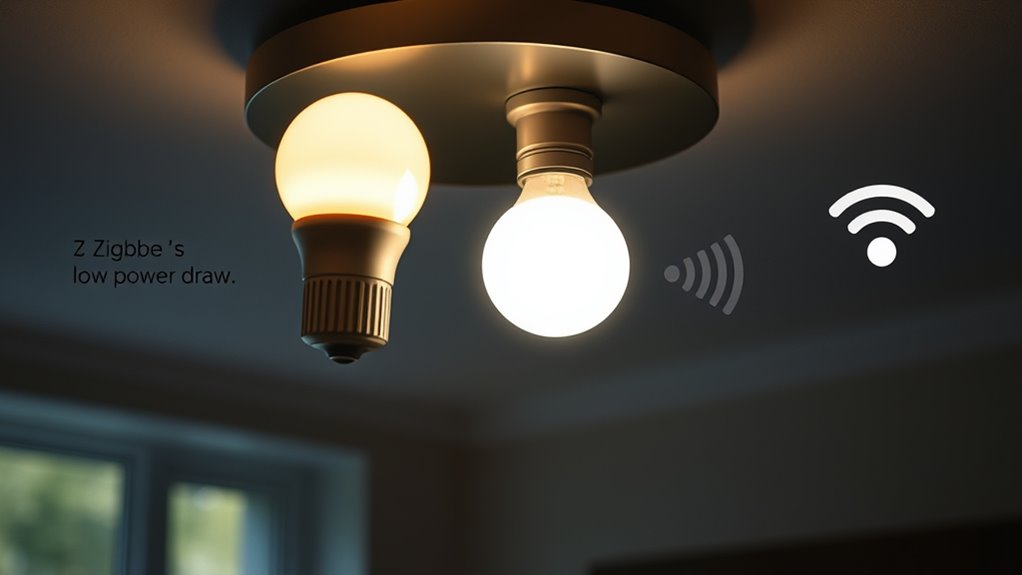
Zigbee and Wi-Fi differ markedly in their power consumption and energy efficiency, which can impact your device’s battery longevity and overall energy conservation. Zigbee’s low power use means your smart bulbs can operate longer between charges, reducing energy costs and environmental impact. Conversely, Wi-Fi consumes more energy, which may drain batteries faster and increase operational expenses. Consider the emotional impact: imagine your bulbs lasting months longer, saving you money and caring for the planet. Here’s a quick comparison: low power consumption contributes significantly to energy savings and device longevity.
| Feature | Zigbee | Wi-Fi |
|---|---|---|
| Power Consumption | Low | High |
| Battery Longevity | Longer | Shorter |
| Energy Conservation | Better | Less Efficient |
| Operating Costs | Lower | Higher |
Choosing Zigbee supports smarter energy conservation and longer-lasting performance.
Ease of Setup and Compatibility
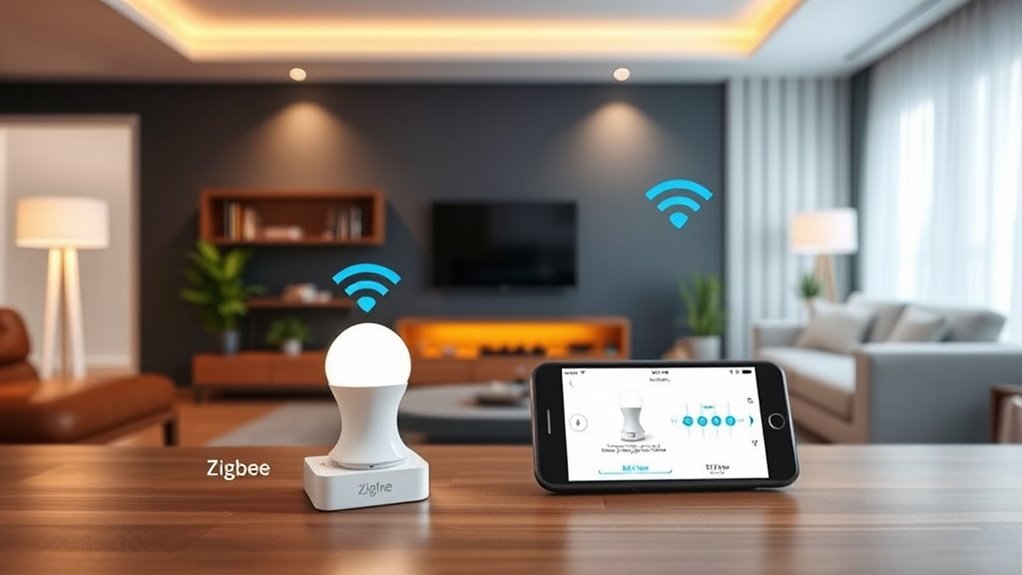
Setting up your devices can be straightforward or frustrating, depending on the system you choose. Zigbee often requires a hub for device pairing, while Wi-Fi devices typically connect directly to your network. Compatibility with other gadgets also varies, influencing how smoothly your smart home ecosystem comes together. Additionally, considering ease of setup and compatibility can help you select the most user-friendly protocol for your needs.
Device Pairing Process
Connecting devices through Zigbee and Wi-Fi varies considerably regarding ease and compatibility. With Zigbee, the installation procedures often involve pairing each device via a dedicated hub, which can take some time but offers a straightforward process once set up. The user interface for Zigbee hubs is typically simple, guiding you step-by-step through device addition. Wi-Fi pairing, on the other hand, usually requires connecting each bulb directly to your home network, often through a smartphone app. This process can be quick or complex depending on your network setup, but most apps provide clear instructions. Overall, Zigbee’s device pairing can be more consistent once the hub is configured, while Wi-Fi offers quick setup but may encounter compatibility issues with different routers or devices. Additionally, interoperability between devices can vary, affecting how easily new devices integrate into your smart home system.
Ecosystem Integration Ease
Once your devices are paired, how smoothly they work together depends largely on how easily they integrate into your existing smart home ecosystem. Zigbee often offers a seamless setup, especially if you stick to devices from the same brand, building brand loyalty and ensuring consistent performance. Its standardized protocols make integration straightforward, preserving the aesthetic appeal of your setup without clutter or confusion. Additionally, Zigbee’s focus on subconscious power during sleep and vibrational alignment can contribute to more harmonious device operation, creating a more cohesive environment. Wi-Fi, on the other hand, may require more effort to connect and manage, especially if you mix brands or devices. However, it usually offers broader compatibility with various devices, giving you flexibility. Ultimately, your experience depends on how well your chosen protocol aligns with your existing ecosystem and preferences for ease of setup, brand cohesion, and visual harmony.
Compatibility With Devices
How easily your devices work together depends largely on their compatibility with your chosen protocol. With Zigbee, brand compatibility can be limited; some brands work better together, while others may require specific hubs or bridges. Wi-Fi, on the other hand, generally offers broader compatibility across a wide range of devices since most smart bulbs connect directly to your home network. Firmware updates are vital for maintaining device performance and security. Zigbee devices often require updates through their hub, which can add an extra step, while Wi-Fi devices typically update automatically over the internet. Consider whether your current devices support your preferred protocol and if firmware updates are straightforward. Confirming compatibility upfront helps avoid frustration during setup and guarantees your smart lighting system functions smoothly long-term. Additionally, understanding the benefits of glycolic acid exfoliation can help you maintain healthy, radiant skin as part of your overall skincare routine.
Data Transmission Speed and Performance
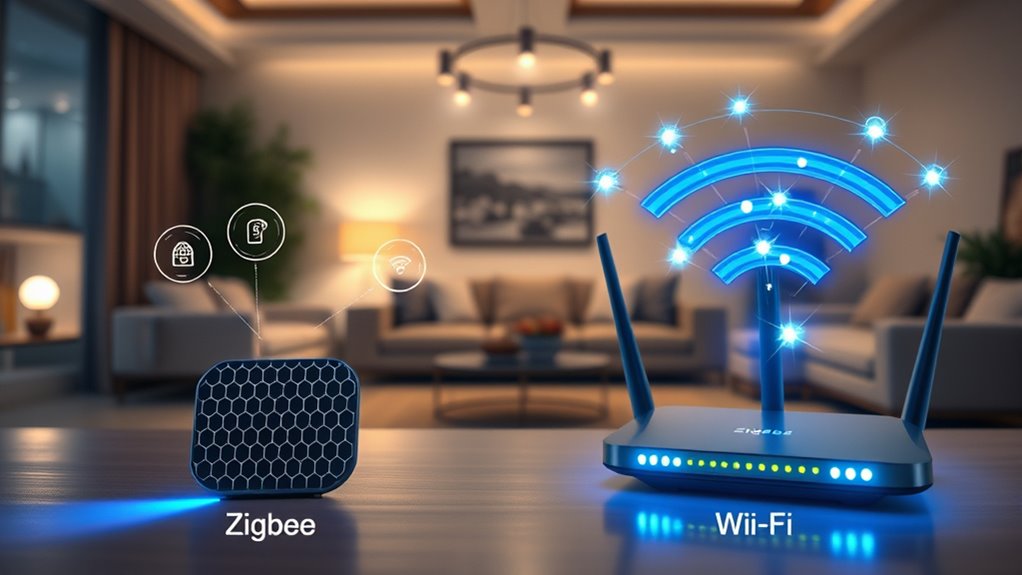
When comparing Zigbee and Wi-Fi regarding data transmission speed and performance, Wi-Fi generally outpaces Zigbee considerably. Wi-Fi offers higher bandwidth, enabling faster data transfer for smart bulbs and related devices. However, this comes with potential bandwidth limitations when many devices are connected simultaneously, possibly slowing down performance. Additionally, Wi-Fi can experience latency issues, especially in congested networks, which may cause delays in commands. Conversely, Zigbee’s lower data rates make it less suitable for high-speed tasks but provide the benefit of:
Wi-Fi offers faster speeds but can face congestion; Zigbee provides stability and low power consumption.
- Lower power consumption for longer device battery life
- Greater network stability in densely populated environments
- Reduced interference, improving overall responsiveness
Moreover, Zigbee’s mesh networking capability allows devices to communicate through multiple paths, enhancing reliability even in crowded wireless environments. Choosing between the two depends on your need for speed versus reliability and power efficiency.
Security Features and Privacy Considerations
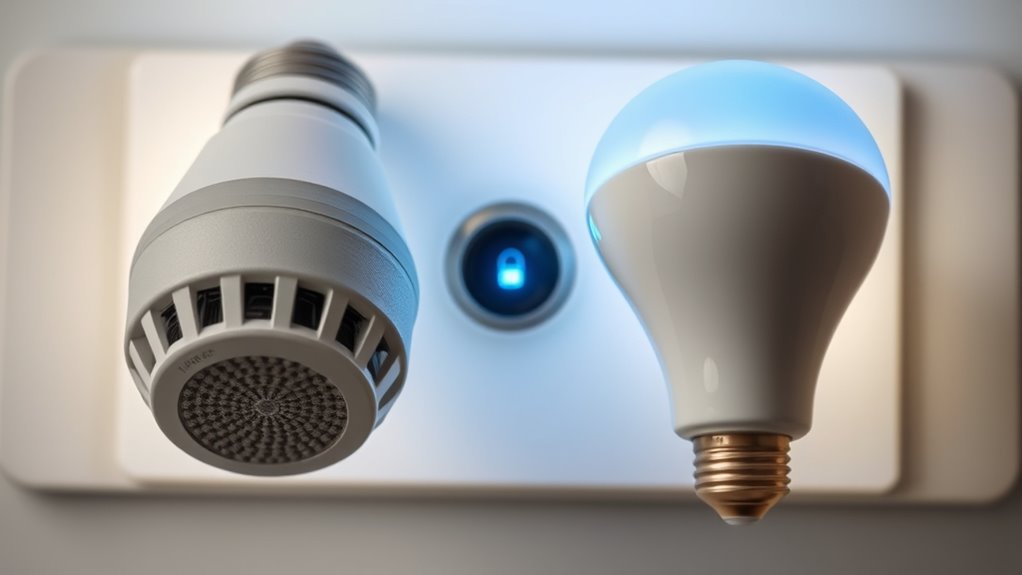
Security is a critical factor when choosing between Zigbee and Wi-Fi for your smart devices. Both protocols prioritize robust encryption standards to protect your data, but they approach security differently. Zigbee uses AES-128 encryption, which is highly secure for low-power devices, ensuring your smart bulbs communicate safely within your network. Wi-Fi typically employs WPA3 encryption, offering strong protection against eavesdropping and unauthorized access. When considering user privacy, Zigbee’s mesh network limits data exposure, adding an extra layer of security. Wi-Fi, being more widely used, may be more vulnerable if not properly secured. Ultimately, both protocols have solid security features, but understanding their encryption standards helps you better safeguard your smart bulbs and protect your user privacy.
Cost Implications and Device Availability
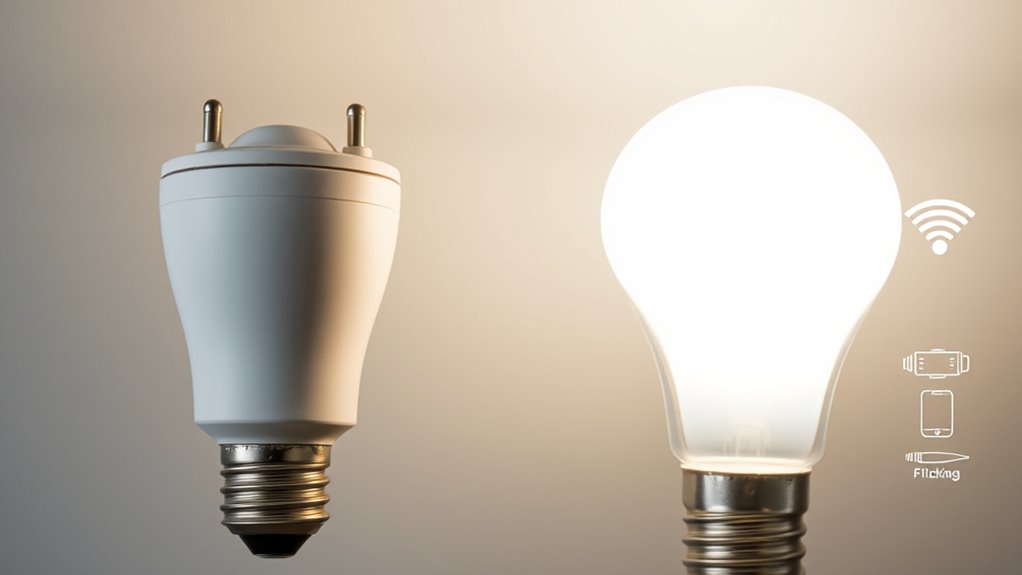
You’ll notice that Zigbee devices generally cost less upfront than Wi-Fi options, but the overall ecosystem can influence your expenses. With Zigbee, you get a wide range of compatible devices, though some may be limited in features or brands. In contrast, Wi-Fi offers more readily available devices that often come at a higher price but guarantee easy integration with your existing network.
Hardware Cost Differences
Hardware costs for Zigbee and Wi-Fi vary considerably, impacting both initial investment and device availability. Zigbee devices typically have lower hardware costs, making them more affordable upfront, especially if you prioritize energy efficiency. Wi-Fi bulbs tend to be pricier due to more complex hardware, but they often come with broader compatibility. Consider these points:
- Zigbee hardware is generally cheaper, benefiting your budget and energy efficiency.
- Wi-Fi devices often cost more but are easier to find, increasing device options.
- The initial investment for Zigbee may be lower, but energy-efficient hardware options are essential for long-term savings.
Understanding these differences helps you choose a protocol that balances hardware affordability with your need for reliable, energy-efficient smart lighting.
Device Ecosystem Options
When selecting between Zigbee and Wi-Fi for your smart lighting, understanding the range of device options and their costs can make a significant difference. Zigbee devices often have limited brand compatibility but are widely supported by hubs, which can add to initial costs. Wi-Fi devices tend to be more universally compatible with various brands, simplifying setup and maintenance. Keep in mind that software updates are essential for security and new features; Wi-Fi devices generally receive updates directly from manufacturers, while Zigbee devices may depend on hub firmware. Here’s a quick comparison:
| Aspect | Zigbee | Wi-Fi |
|---|---|---|
| Brand Compatibility | Limited, depends on hubs | Broad, compatible with many |
| Cost Implications | Usually cheaper devices | Slightly higher device costs |
| Software Updates | Via hub firmware updates | Directly from device makers |
Compatibility and Price
Choosing between Zigbee and Wi-Fi for your smart lighting largely depends on compatibility and cost. Your device ecosystem plays a pivotal role in this decision.
- Brand Compatibility: Zigbee often works best with specific hubs and brands, limiting options but ensuring seamless integration. Wi-Fi devices are generally more flexible, compatible with most routers and smart home platforms.
- Price Comparison: Zigbee bulbs and hubs tend to be more affordable long-term, especially if you already have a compatible hub. Wi-Fi bulbs might cost more upfront but don’t require extra hubs.
- Device Availability: Wi-Fi smart bulbs are widely available in many stores, giving you more choices. Zigbee options are more limited but often more reliable for large setups.
Assess your existing devices and budget to choose the most compatible and cost-effective protocol.
Scalability and Network Management
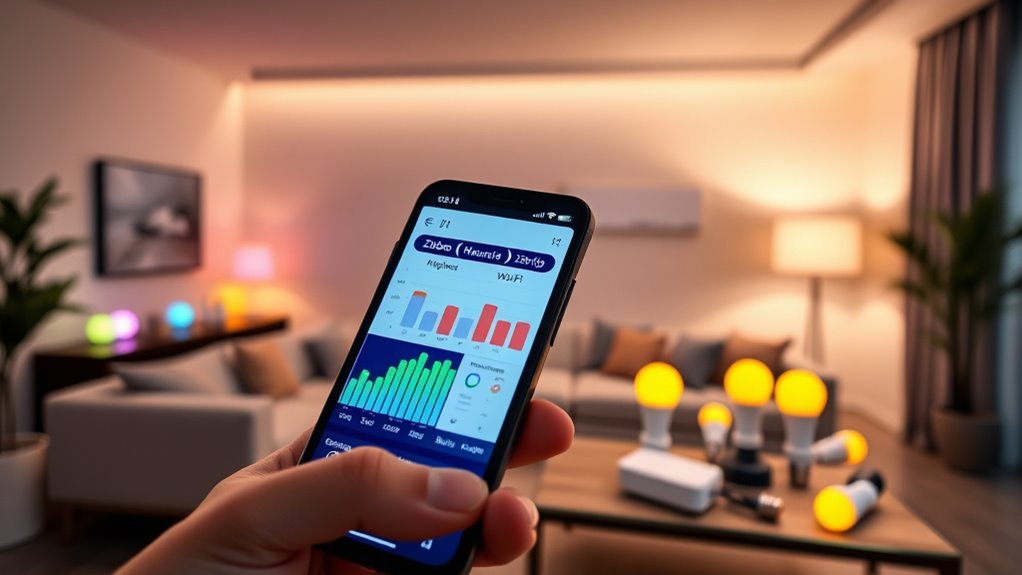
How well a network scales and manages growth often determines its long-term viability. When choosing between Zigbee and Wi‑Fi, consider device scalability and network management. Zigbee networks excel with low power consumption and easy expansion, supporting many devices with mesh topology. Wi‑Fi, while familiar and straightforward, can become congested as more devices connect, making network management more complex. To help you compare, here’s a simple overview:
| Feature | Zigbee | Wi‑Fi |
|---|---|---|
| Device scalability | High; mesh network supports many | Moderate; limited by bandwidth |
| Network management | Easier; dedicated for IoT devices | More complex; shares network |
| Power consumption | Low; ideal for smart bulbs | Higher; uses more energy |
Integration With Smart Home Ecosystems

Integrating Zigbee and Wi-Fi devices into your smart home ecosystem influences overall convenience and compatibility. Both protocols support seamless integration, but they differ in how they connect with your existing systems. Here’s what you should consider:
Integrating Zigbee and Wi-Fi devices enhances smart home convenience and compatibility.
- Voice control: Zigbee devices often work better with dedicated hubs, providing reliable voice commands through platforms like Alexa or Google Assistant. Wi-Fi devices typically connect directly to your Wi-Fi network for quick setup.
- Cloud integration: Wi-Fi bulbs usually offer smoother cloud integration, enabling remote control via apps. Zigbee devices may rely on hubs, which can add a layer of complexity but improve local control.
- Ecosystem compatibility: Check if your smart home ecosystem supports both protocols to ensure easy device integration, maximizing your setup’s flexibility and responsiveness.
Making the Right Choice for Your Smart Bulbs
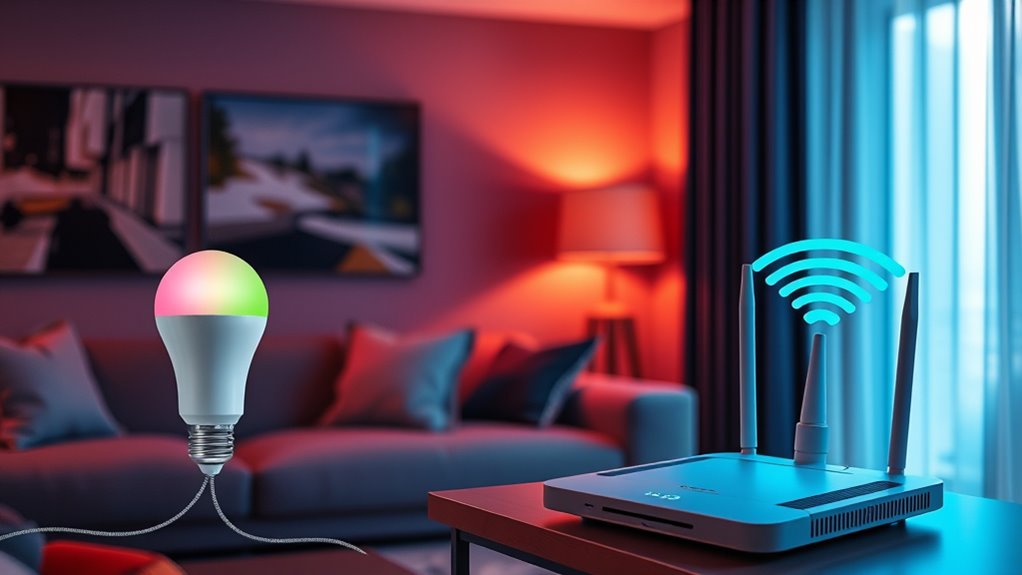
Deciding between Zigbee and Wi-Fi smart bulbs depends on your priorities for connectivity, ease of use, and system compatibility. If you value seamless lighting customization and want more control over brightness, color, and scheduling, Zigbee often offers more reliable performance within a mesh network. It also supports energy monitoring features that help you track power consumption efficiently. On the other hand, Wi-Fi bulbs are typically easier to set up, especially if your home already has a strong Wi-Fi signal, and they work directly with your existing network without additional hubs. Consider your home’s existing infrastructure and how much control you want over lighting options and energy use. Making the right choice guarantees your smart lighting system fits your lifestyle perfectly.
Frequently Asked Questions
Which Protocol Offers Better Long-Term Reliability for Smart Bulb Networks?
You want a reliable smart bulb network, so consider which protocol offers better long-term stability. Wi-Fi often provides stronger network stability if you have a solid router, but Zigbee is designed for low power and mesh networks, enhancing hardware durability and reliability over time. For lasting network performance, Zigbee’s mesh capability guarantees consistent coverage, making it a smarter choice for long-term reliability in your smart home.
Can Both Zigbee and Wi-Fi Be Used Simultaneously in a Smart Home?
While juggling multiple protocols might seem intimidating, you can definitely use Zigbee and Wi-Fi together in your smart home. This setup allows for flexible interference management and improved network compatibility, ensuring your devices work seamlessly. By carefully configuring your network, you can enjoy the benefits of both protocols without hassle, making your smart home more versatile and reliable. It’s all about creating a harmonious system that fits your needs.
How Do Firmware Updates Differ Between Zigbee and Wi-Fi Smart Bulbs?
When updating your smart bulbs, you’ll notice firmware security and update frequency differ between Zigbee and Wi-Fi models. Zigbee bulbs typically receive updates less frequently, emphasizing security enhancements, but they often require a hub for firmware updates. Wi-Fi bulbs update more often directly over your internet connection, allowing quicker firmware security patches. This means with Wi-Fi, you stay current faster, but with Zigbee, updates might be less frequent but equally secure.
Are There Environmental Factors That Affect Zigbee or Wi-Fi Performance?
Think of your smart bulbs as delicate dancers, affected by environmental factors. Interference sources like thick walls, other wireless devices, or metal objects can disrupt Wi-Fi signals, much like noise on a phone call. Zigbee, on the other hand, is more resilient but can still be influenced by interference sources. Power fluctuations also impact both protocols, causing connectivity issues. Keep your environment in mind to guarantee smooth, reliable smart bulb performance.
What Is the Typical Lifespan Comparison of Zigbee Versus Wi-Fi Smart Bulbs?
You’ll find that Zigbee smart bulbs generally have a longer lifespan compared to Wi-Fi bulbs because they consume less energy, making them more energy efficient. Zigbee bulbs rely on low-power communication, which extends their battery life if they’re battery-powered, and reduces wear on electrical components. Wi-Fi bulbs tend to have shorter lifespans due to higher power consumption, but they often don’t require batteries, making their operational life dependent on the bulb’s hardware durability.
Conclusion
Imagine your smart bulbs glowing softly, seamlessly part of your home’s heartbeat. Whether Zigbee’s quiet efficiency or Wi-Fi’s swift speed suits your needs, choosing the right protocol is like picking the perfect thread for your home’s tapestry. Consider your space, energy habits, and future plans. With the right connection, your smart lighting becomes a warm, inviting glow—an effortless dance of technology and comfort illuminating your everyday life.









